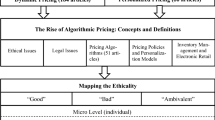Abstract
This paper proposes a discrete bidding model for both quantities and pricing. It has a two-unit demand environment where subjects bid for contracts with an unknown redemption value, common to all bidders. Prior to bidding, the bidders receive private signals of information on the (common) value. The relevant task is to compare the equilibrium strategies and the seller’s revenue of the three most common auction formats with two players. The result is that the Vickrey auction always gives the most revenue to the seller, the discriminatory auction follows closely and the uniform auction clearly is the worst due to demand reduction.
Similar content being viewed by others
Notes
The issue of demand reduction has been studied in more detail by Ausubel and Crampton (2002).
Levin (2005) has showed that, in an IPV setting with a reservation price equal to zero, any bid on the first unit weakly above the endpoints of the value-distribution is an equilibrium bid, as long as there are as many bidders as units for sale.
For this to be true in this setting we must have that the value function satisfies what Ausubel (1999) calls value monotonicity and value regularity. This, indeed, is true for the value function in this paper.
References
Ausubel, LM (1999) A generelized Vickrey auction. Mimeographed, University of Maryland
Ausubel LM, Crampton PC (2002) Demand reduction and inefficiency in multi-unit auctions. Mimeographed, Department of Economics, University of Maryland
Ausubel LM, Milgrom P (2006) The lovely but lonely Vickrey auction. In: Cramton P, Shoham Y, Steinberg R (eds) Combinatorial auction. MIT, Cambridge, pp 17–40
Levin D (2005) Demand reduction in multi-unit auctions: evidence from a sportscard field experiment: comment. Am Econ Rev 95(1):467–471
Lindén J, Lunander A, Nilsson J-E (1996) Revenues in multi-unit common value auctions—an experimental study of three sealed-bid mechanisms. Mimeographed, Dalarna University
Noussair C (1995) Equilibria in a multi-unit uniform price sealed bid auction with multi-unit demands. Econ Theory 5:337–351
Acknowledgement
The author wants to thank Mark Voorneveld for support.
Author information
Authors and Affiliations
Corresponding author
Appendix
Appendix
Proof
The equilibrium prescribes equal bids on both units and the payoff is:
Now, suppose she deviates and bids b′(t i ) = b(t i − l), where l ∈ ℤ + , i.e, she mimics a type-(t i − l) type. Then, she will always lose both units when playing against another type-t i bidder and, depending on which type she mimics, both will win one unit each when playing against each other. It shows that the best she can do is to mimic a type-(t i − 1) player, but it is not good enough since she will then only get payoff:
Which shows, if we use the relation: \(\lceil \frac{t_i}{3} \rceil - 1 \leq \lceil \frac{t_i - 1}{3} \rceil\), that:
If, on the other hand, the player deviates by raising the bid compare to the equilibrium bid, and bids b′(t i ) = b(t i + l), where l ∈ ℤ + , i.e, she mimics a type-(t i + l) type. Then, she will always win both units when playing against another type-t i bidder and, depending on which type she mimics, both will win one unit each when playing against each other. It shows that the best she can do is to mimic a type-(t i + 1) player, but it is not good enough since she will then only get payoff:
If we use the relation: \(\lceil \frac{t_i}{3} \rceil \leq \lceil \frac{t_i + 1}{3} \rceil\), we have:
Thus, no one has any incentives to deviate from the proposed equilibrium strategy. □
About this article
Cite this article
Ahlberg, J. Revenues in discrete multi-unit, common value auctions: a study of three sealed-bid mechanisms. Port Econ J 8, 3–14 (2009). https://doi.org/10.1007/s10258-009-0042-z
Received:
Accepted:
Published:
Issue Date:
DOI: https://doi.org/10.1007/s10258-009-0042-z




